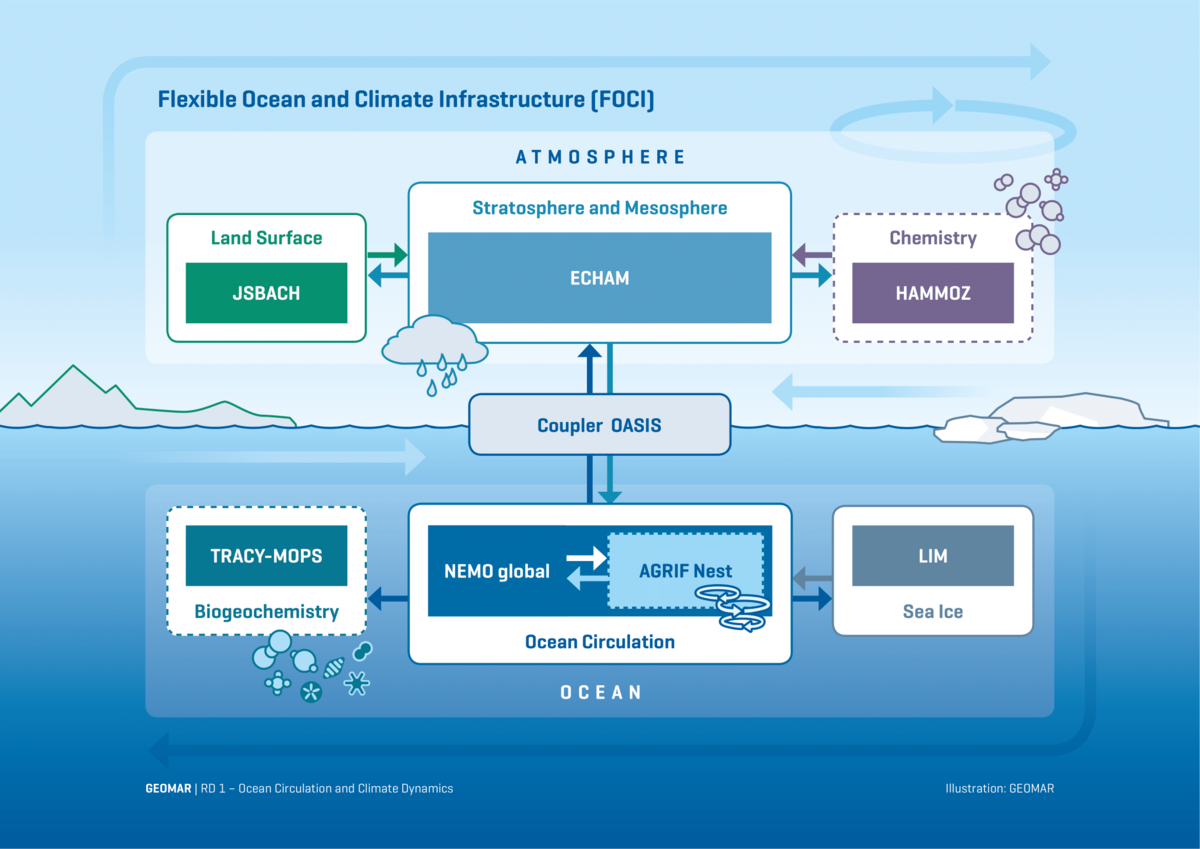Modelling
The Earth's climate is characterized by a complex interplay between the oceans, the atmosphere, sea and land ice, the vegetation, the biogeochemical cycles, and the influence of external factors. The feedbacks between the different climate subsystems and the variability of the climate system on different timescales are only partly understood.
Climate modelling provides a useful tool to investigate variability and feedbacks in a systematic way. The performance and sensitivity of climate models can be tested against instrumental observations and paleo-reconstructions. Our modelling efforts cover a wide range of climate fluctuations on seasonal, inter-annual, multi-decadal, and centennial time scales in the past, present and future climates taking into account natural drivers and anthropogenic influences.
Models used in Marine Meteorology:
- Coupled Atmosphere-Ocean physics models:
FOCI (ECHAM6/NEMO),
FOCI-OpenIFS (OpenIFS/NEMO) - Lagrangian trajectory code: TRACMASS
- coupled Earth system model: FOCI-ESM (ECHAM6/NEMO/MOPS/JSBACH)
- intermediate complex Earth system model: UVic ESCM
The Flexible Ocean and Climate Infrastructure (FOCI)
The first version of FOCI consists in its default setup of a global high-top atmosphere (European Centre Hamburg general circulation model; ECHAM6.3), a land surface model (Jena Scheme for Biosphere Atmosphere Coupling in Hamburg; JSBACH), a ocean model (Nucleus for European Modelling of the Ocean v3.6; NEMO3.6) as well as sea-ice (Louvain-la-Neuve sea Ice Model version 2; LIM2) which are coupled through the OASIS3-MCT software package.
A unique feature of FOCI is the ability to crank up the resolution in the ocean regionally using NEMO's AGRIF feature. These so-called ocean nests have been implemented for e.g. the North Atlantic or parts of the Southern Ocean. All ocean nest configurations that have been used in RD1 in either forced ocean simulations or fully coupled ocean-atmosphere setups are described on a separate page. As indicated in the schematic above, an optional module to include biogeochemical processes in the ocean (MOPS) is available and actively used.
In addition to the standard version of ECHAM6, a version of ECHAM6 that allows for the interactive calculation of aerosols and/or chemical processes is available. This version referred to as ECHAM6-HAMMOZ (Schultz et al., 2018) is used to study the ozone hole variability under present and future climate conditions. In the current setup, FOCI is mostly configured to run at a horizontal resolution of 1.8° with 95 vertical levels (T63L95). It allows the model realistically simulate important dynamical processes such as the quasi-biennial oscillation (QBO).
As the performance of ECHAM6 rapidly decreases if the horizontal resolution is higher than approximately 1° the climate version of ECMWF's operational forecast model, OpenIFS, has been implemented into FOCI. In contrast to ECHAM6, OpenIFS is still actively developed and scales very well at very high model resolutions. This allows us to reduce the mismatch in resolution between the high-resolution regional ocean nests and the rather coarse horizontal resolution of ECHAM6 in the atmosphere.
FOCI is the successor of KCM (developed at GEOMAR more than 10 years ago) with updated model components and additional options that were not available in KCM.
Contributors: Sebastian Wahl



